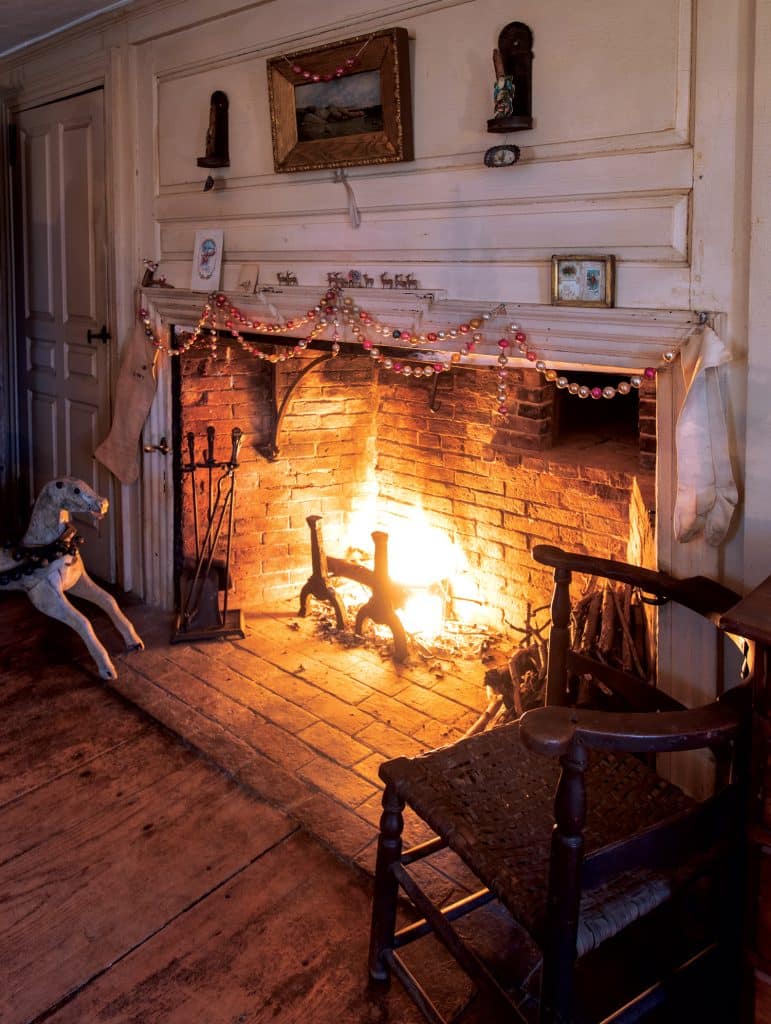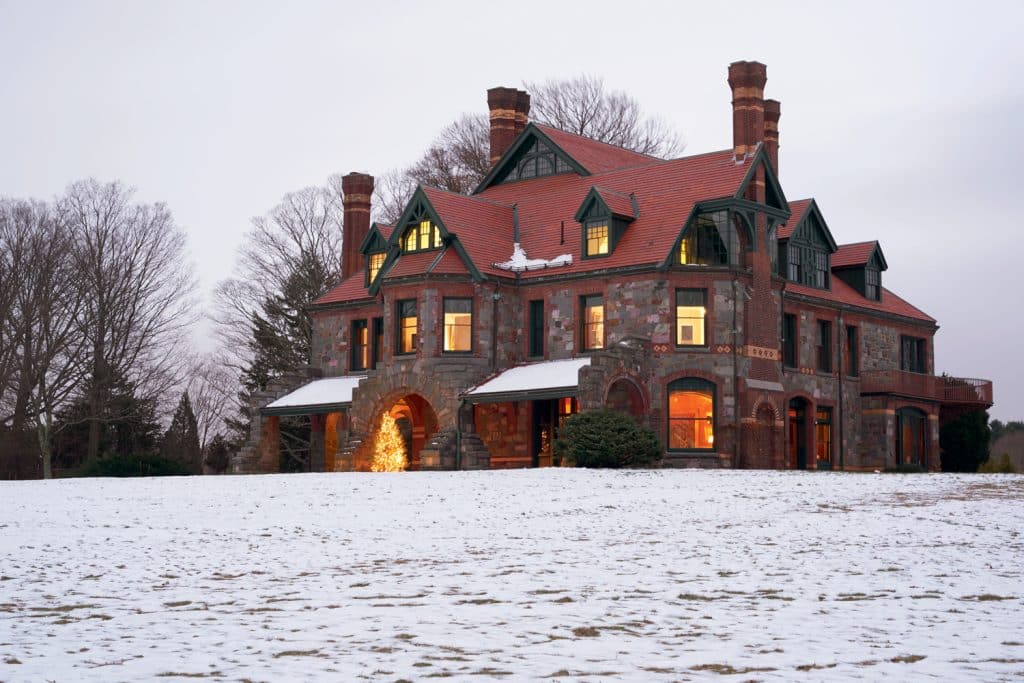Hearth of the Matter | A Timeline of Santa’s Fireplace Challenges
Children know it’s magic. For the rest of us, here’s a brief history of Santa’s fireplace escapades.

Coffee By Design | Portland, Maine
Photo Credit : Katherine KeenanBefore we get to Santa, let’s set the stage for his arrival in the New World.
North America was full of surprises for Europeans, and perhaps none was so perplexing as the climate. Colonial settlers knew about latitude and made a commonsense assumption that things would be pretty much the same at similar latitudes wherever one went. London was 51 degrees north, so New England—in the low 40s and “neerer the Sunne”—was expected to be a lot like Spain or southern France. What settlers found instead were wicked-hot summers and “sharp” winters.
William Wood’s 1634 New England’s Prospect, a kind of travel guide, admitted the problem and prescribed a solution: “But it may be objected that it is too cold a country for our English men, who have been accustomed to a warmer climate. To which it may be answered … there is wood good store and better cheap to build warm houses and make good fires, which makes the winter less tedious.”
And so the colonists put up warm houses, equipping them with what was, in the early 17th century, a fairly new feature of domestic architecture: the chimney. Where they’d come from in England, the usual heating and cooking arrangement in a simple home had been a hearth in the main room with a hole in the roof or gable end to let out the smoke. Here, with plenty of wood around and an urgent need to ignite it, they built New World central-heating plants, starting with wattle-and-daub (aka stick-and-mud) chimneys but switching to ignition-proof brick as soon as they could. Some of the fireplaces were truly awesome, full of cooking hardware (andirons, pokers, tongs, shovels, spits, kettles, cooking cranes, ladles, trivets, frying pans, Dutch ovens, and built-in baking ovens) and up to 10 feet wide, with massive timber lintels that could have been hung with an epic number of stockings.
They were ready for Santa … but it would be another century until he was ready for them. He first appeared in American print on December 23, 1773, in a New York City newspaper, which announced that “St. Nicholas, otherwise called St. a Claus” had been honored by a fraternal order in town. “St. a Claus” was an Anglicization of the Dutch Sinterklass, a gift-bearing patron saint of children in the Netherlands. In 1809, writer Washington Irving published his satirical Knickerbocker’s History of New York (1809), describing “good St. Nicholas … riding over the tops of the trees, in that self-same wagon wherein he brings his yearly presents to children”; in an expanded 1812 version he has the saint “rattl[ing] down the chimney,” the first-known reference to our fur-trimmed hero’s traditional method of home access. A few years later, Irving’s acquaintance Clement Clark Moore sealed this image with his blockbuster account of “the night before Christmas.”

Photo Credit : Kindra Clineff
Santa had plenty of big chimneys to rattle down in the early 1800s, from the by-then old-fashioned central versions—their huge mass of bricks serving multiple fireplaces, firmly planted in the middle of the house—to smaller, more stylish gable-end ones that freed up floor plans.
In his 1856 short story “I and My Chimney,” Herman Melville drolly recounts his battle to preserve his old home’s central chimney from his wife’s modernizing crusade to replace it with end units. He prevailed, but there were even bigger threats to Santa afoot. The development of the American coal and iron industries gave rise to the cast-iron stove, manufactured in parts and easily shipped, often decoratively designed, and vastly more efficient than open hearths. Inserted into fireplaces, they sometimes used the existing flue but drafted best when served by a narrow metal pipe. They gained popularity in the 1830s and ’40s, at the same time Greek Revival architecture was coming into fashion. Part of signaling the style’s up-to-date-ness was its decided lack of smoky old fireplaces and bulky chimneys: Slender was in, made possible by stoves and their more modest venting needs. Interestingly, folks still framed their stoves with decorative mantels—good for stockings, but how the heck was Santa to deal with that newly narrowed entry point?
It was a question on many young people’s minds, with published letters to Santa at the time inquiring, “Do you crawl down stovepipes?” O ye of little faith! The more obstacles, the more magic—obviously. Ralph Bates Silloway surely spoke for many of his believing contemporaries in his 1903 letter to Santa, in which, after asking for “that thing that nods its head, and a big train, freight and passenger and a coal car and an engine, and that is all,” he confidently signed off, “So good-bye, Santa. I watch for you every night in the stove.”

Photo Credit : Mark Fleming

Photo Credit : Rikki Snyder
Santa-related obstacles continued to pile up, as homes modernized with central furnaces, also vented through hard-to-crawl-down pipes or tall, narrow chimneys. What fireplaces remained were now for mostly aesthetic enjoyment, so at least they were free of hazardous cooking paraphernalia. New Victorian-era architectural styles featured elaborate chimneys to complement their other exuberant details, but even then there were curveballs. Mark Twain’s 1874 Stick Style mansion in Hartford, Connecticut, featured a dining room fireplace with a window over it—it’s said he enjoyed watching the snow seemingly fall into the blaze below—made possible by splitting the flue into two narrow passages flanking the fenestration. Great at soirees, no doubt, but a real trick to navigate on Christmas Eve. (There’s no record of the Clemens children’s take on the matter.)
The year 1876 brought good news for Santa, as the country’s centennial triggered a wave of nostalgia for the early days of America, and the Colonial Revival architecture that emerged marked a return to the broad chimneys of yore. Still, there were worries. In 1893, a concerned writer contributed a lengthy opinion piece to Harper’s Weekly, lamenting Santa’s inability to stay current: “We know of no contemporary personage who is suffering more from allowing himself to drop behind the times than our friend Santa Claus.… The notion of Santa Claus coming down a steam-pipe or up through a register was even more absurd than the idea of his braving the dimensions of a stove-pipe.… When the air-tight stove was introduced, a mode of ingress other than the chimney should have been provided.”
Clearly the writer was not consulting enough children, if any. Like Ralph Bates Silloway, kids are not interested in letting silly things like “air-tight stoves” or “gravity hot-air heat” or even “heat pumps” or “high-rise condominiums” stand between their guy and a satisfying Christmas morning. Interviewed earlier this year, and asking that her full name not be used, Elaina A., a 6-year-old from Vermont, reports that Santa has no issues with her home’s woodstove. “He’s not as big as people are, so he can fit down the pipe. We usually have a fire going, but his clothes protect him. He’s magic anyway, so he can fit through the little holes in the bottom of the stove and then comes out through the ash box.” Levi K., a 6-year-old in Maine, has considered the fact that his house has a chimney, but its fireplace is now hidden behind a plaster wall. “If he went down our chimney, he’d get trapped inside. So he’s watched us and knows where we keep the spare key outside. He uses that to unlock the door, comes in, locks the door from inside, leaves the presents, then goes back out and locks the door behind him.” (Note Santa’s attention to security, something Levi appreciates.)
So yes, Virginia, no matter what we come up with to keep our New England houses warm, no matter how tight we build them or how many stories tall, Santa will always find a way in.







